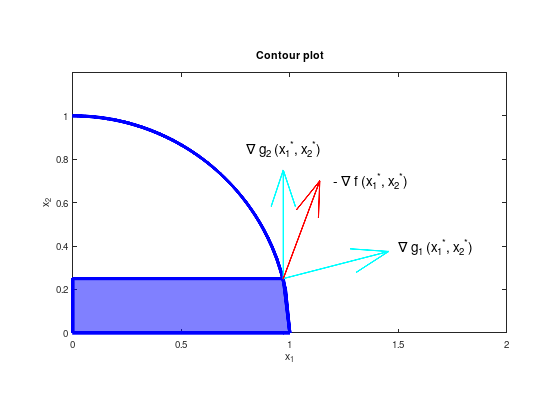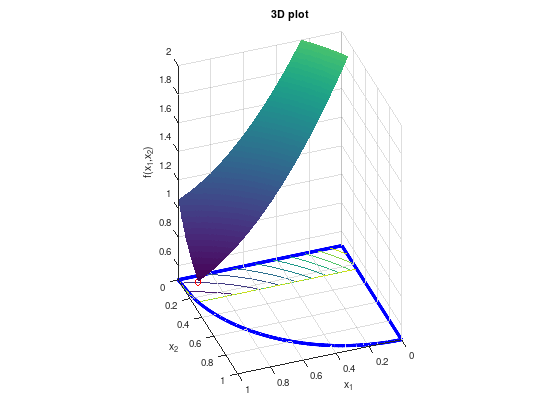RM02
Contents
RM02#
Consider the following constrained optimization problem:
with
The optimal point is \(\begin{pmatrix} {x_1}^{*} \\ {x_2}^{*} \end{pmatrix}\) \(= \frac{1}{4} \begin{pmatrix} \sqrt{15} \\ 1 \end{pmatrix}\) \(\approx \begin{pmatrix} 0.97 \\ 0.25 \end{pmatrix}\) with \(f({x_1}^{*}, {x_2}^{*}) \approx 0.64\) and \(\nabla f({x_1}^{*}, {x_2}^{*}) = \frac{1}{2} \begin{pmatrix} \sqrt{15} - 5 \\ -3 \end{pmatrix}\) \(\approx \begin{pmatrix} -0.56 \\ -1.5 \end{pmatrix}\)
% Optimal point.
px = 0.97;
py = 0.25;
% Visualize constrained set of feasible solutions (blue).
area ([0 1 0.97 0 0], [0 0 1/4 1/4 0], ...
'FaceColor', 'blue', ...
'FaceAlpha', 0.5, ...
'LineWidth', 4, ...
'EdgeColor', 'blue');
% Visualize scaled gradients of objective function (red arrow)
% and constraint functions (cyan arrows).
hold on;
x = 0:0.02:1;
plot (x, sqrt (1 - x.^2), 'LineWidth', 4, 'b');
quiver (px, py, 0.5 * px, 0.5 * py, 'LineWidth', 2, 'c');
quiver (px, py, 0, 0.5, 'LineWidth', 2, 'c');
quiver (px, py, 0.3 * 0.56, 0.3 * 1.5, 'LineWidth', 2, 'r');
text (1.2, 0.70, '- \nabla f ({x_1}^{*}, {x_2}^{*})', 'FontSize', 14);
text (0.8, 0.85, '\nabla g_2 ({x_1}^{*}, {x_2}^{*})', 'FontSize', 14);
text (1.5, 0.40, '\nabla g_1 ({x_1}^{*}, {x_2}^{*})', 'FontSize', 14);
axis equal;
xlim ([0 2.0]);
ylim ([0 1.2]);
xlabel ('x_1');
ylabel ('x_2');
title ('Contour plot');

% Optimal point.
px = 0.97;
py = 0.25;
[X1, X2] = meshgrid (linspace (0, 1, 500));
FX = (X1 - 1.25).^2 + (X2 - 1).^2;
% Remove infeasible points.
FX((X1.^2 + X2.^2) > 1) = inf;
FX(X2 > 0.25) = inf;
surfc (X1, X2, FX);
shading flat;
hold on;
x = 0:0.02:1;
plot3 (x, sqrt (1 - x.^2), 0.5 .* ones (size (x)), 'LineWidth', 4, 'b');
plot3 ([1 0 0], [0 0 1], [0.5 0.5 0.5], 'LineWidth', 4, 'b');
plot3 (px, py, (px - 1.25)^2 + (py - 1)^2, 'ro');
xlabel ('x_1');
ylabel ('x_2');
zlabel ('f(x_1,x_2)');
title ('3D plot');
axis equal;
zlim ([0.5, 2]);
view (160, 35);

At the optimal point only the constraints \(g_{1}\) and \(g_{2}\) are active, thus \({\lambda_3}^{*} = {\lambda_4}^{*} = 0\).
According to KKT, there exist unique \({\lambda_1}^{*} \geq 0\), \({\lambda_2}^{*} \geq 0\) with
thus \({\lambda_1}^{*} = \frac{1}{3} (\sqrt{15} - 3) \approx 0.29\) and \({\lambda_2}^{*} = \frac{12 - \sqrt{15}}{6} \approx 1.35\).
Numerical experiment (only Matlab)#
function RM02 ()
% Nonlinear objective function.
fun = @(x) (x(1) - 1.25).^2 + (x(2) - 1).^2;
% Starting point.
x0 = [1, 0.25];
% Linear inequality constraints A * x <= b.
A = [];
b = [];
% Linear equality constraints Aeq * x = beq.
Aeq = [];
beq = [];
% Bounds lb <= x <= ub
lb = [0, 0]; % g_3 and g_4
ub = [10, 0.25]; % g_2
% Call solver.
[x,fval,exitflag,output,lambda,grad,hessian] = fmincon (fun,x0,A,b,Aeq,beq,lb,ub,@nonlcon);
% Display interesting details.
exitflag % == 1 success
x % optimal solution
fval % function value at optimal solution
grad % gradient of fun at optimal solution
hessian % Hessian matrix of fun at optimal solution
lambda % Lagrange parameter
lambda.lower % lambda_3 and lambda_4
lambda.upper(2) % lambda_2
lambda.ineqnonlin % lambda_1
end
% Nonlinear constraint function for g_1.
function [c,ceq] = nonlcon(x)
c = x(1).^2 + x(2).^2 - 1;
ceq = 0;
end
